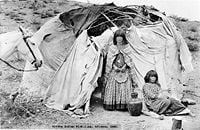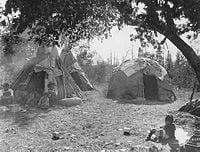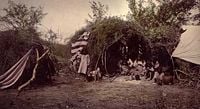Wigwam
- For other uses, see Wigwam (disambiguation).

A wigwam or wickiup is a domed single-room dwelling used by certain Native American tribes. The term wickiup is generally used to label these kinds of dwellings in American Southwest and West. Wigwam is usually applied to these structures in the American Northeast. The use of these terms by non-Native Americans is somewhat arbitrary and can refer to many distinct types of Native American structures regardless of location or cultural group. The wigwam is not to be confused with the Native Plains tipi which has a very different construction, structure, and use.
Structure
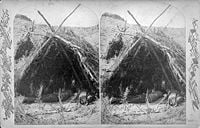
The domed, round shelter is used by many different Native American cultures. The curved surfaces make it an ideal shelter for all kinds of conditions. It was as safe and warm as the best houses of early colonists.[citation needed]
These structures are formed with a frame of arched poles, most often wooden, which are covered with some sort of roofing material. Details of construction vary with the culture and local availability of materials. Some of the roofing materials used include grass, brush, bark, rushes, mats, reeds, hides or cloth.
Wigwams of Northeast
Wigwams are most often seasonal structures although the term is applied to rounded and conical structures built by Native American groups that are more permanent. Wigwams usually take longer to put up than tipis and their frames are usually not portable like a tipi.
A typical wigwam in the Northeast has a curved surface which can hold up against the worst weather. The male of the family was responsible for the framing of the wigwam. Young green tree saplings, of just about any type of wood, about ten to fifteen feet long were cut down. These tree saplings were then bent by stretching the wood. While these saplings were being bent, a circle was drawn on the ground. The diameter of the circle varied from ten to sixteen feet. The bent saplings were then placed over the drawn circle, using the tallest saplings in the middle and the shorter ones on the outside. The saplings formed arches all in one direction on the circle. The next set of saplings was used to wrap around the wigwam to give the shelter support. When the two sets of saplings were finally tied together, the sides and roof were placed on it. The sides of the wigwam were usually bark stripped from trees.
Mary Rowlandson uses the term Wigwam in reference to the dwelling places of the Native Americans that she stayed with while in their captivity during King Philip's War in 1675. The term wigwam has remained in common English usage as a synonym for any "Indian house", however this usage is incorrect as there is knowledgeable differences between the wigwam and the tipi within the Native American community.
Wickiups of Southwest and West
The regional non-Native American term for a single room dome like dwellings is wickiup. A distinction is usually made between them and a tipi, a hogan or a kiva. There is a great deal of variation in size, shape and materials.
Below is a description of Chiricahua wickiups recorded by anthropologist Morris Opler:
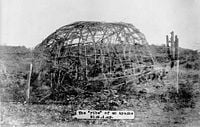
- "The home in which the family lives is made by the men and is ordinarily a circular, dome-shaped brush dwelling, with the floor at ground level. It is eight feet high at the center and approximately seven feet in diameter. To build it, long fresh poles of oak or willow are driven into the ground or placed in holes made with a digging stick. These poles, which form the framework, are arranged at one-foot intervals and are bound together at the top with yucca-leaf strands. Over them a thatching of bundles of big bluestem grass or bear grass is tied, shingle style, with yucca strings. A smoke hole opens above a central fireplace. A hide, suspended at the entrance, is fixed on a cross-beam so that it may be swung forward or backward. The doorway may face in any direction. For waterproofing, pieces of hide are thrown over the outer hatching, and in rainy weather, if a fire is not needed, even the smoke hole is covered. In warm, dry weather much of the outer roofing is stripped off. It takes approximately three days to erect a sturdy dwelling of this type. These houses are 'warm and comfortable, even though there is a big snow.' The interior is lined with brush and grass beds over which robes are spread...." (Opler: 22-23)
- "The woman not only makes the furnishings of the home but is responsible for the construction, maintenance, and repair of the dwelling itself and for the arrangement of everything in it. She provides the grass and brush beds and replaces them when they become too old and dry.... However, formerly 'they had no permanent homes, so they didn't bother with cleaning.' The dome-shaped dwelling or wickiup, the usual home type for all the Chiricahua bands, has already been described.... Said a Central Chiricahua informant:
- Both the tipi and the oval-shaped house were used when I was a boy. The oval hut was covered with hide and was the best house. The more well-to-do had this kind. The tepee type was just made of brush. It had a place for a fire in the center. It was just thrown together. Both types were common even before my time....
- "A house form that departs from the more common dome-shaped variety is recorded for the Southern Chiricahua as well:
- ...When we settled down, we used the wickiup; when we were moving around a great deal, we used this other kind..." (Opler: 385-386)
'Wigwam' in different Algonquian languages
These terms are possible Native American sources of the current terms (the Proto-Algonquian term was *wi·kiwa·Hmi)—
wigwam:
- wiquoam literally 'their house' in Delaware (cf. n1: neek 'my house', n2: keek 'thy house', n3: week 'his house')
- wikuwam in Eastern Wabenaki (Maliseet)
- wigwôm in Western Wabenaki (Abenaki language)
- ȣichiȣam in the Nipmuc language
- wiigiwaam in the Anishinaabe languages; syncoped as wiigwaam
- wiigiwaam in the Algonquin language can vary as miigiwaam (with the nX prefix m- instead of n3 prefix w-)
- ookóówa in the Blackfoot language (without the possessive theme suffix -m)
- mâhëö'o in the Cheyenne language (with the nX prefix m- instead of n3 prefix w- and without the possessive theme suffix -m)
wickiup (perhaps a variant of wikiwam without the possessive theme suffix -m combined with ap(i) "sit"):
- wiikiyaapi in Fox
- wekeab in Saki
- wikiop in Menominee
- mekewāp in Cree (with the nX prefix m- instead of n3 prefix w-)
- mīciwāhp in Montagnais (with the nX prefix m- instead of n3 prefix w-)
External links
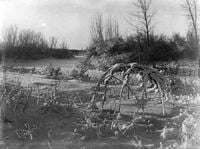
- Chiricahua wickiup (picture)
- making of a wickiup (including pictures)
- drawing of a wickiup
- Native American homes
See also
- Tipi - another type of Native American dwelling.
- Sweat lodge - a ceremonial sauna that is often built in the wickiup style
- Hogan or hooghan in Navajo uses earth in its construction
ReferencesISBN links support NWE through referral fees
- Opler, Morris E. (1941). An Apache life-way: The economic, social, and religious institutions of the Chiricahua Indians. Chicago: The University of Chicago Press. (Reprinted in 1962, Chicago: University of Chicago Press; 1965, New York: Cooper Square Publishers; 1965, Chicago: University of Chicago Press; & 1994, Lincoln: University of Nebraska Press, ISBN 0-8032-8610-4).
Credits
New World Encyclopedia writers and editors rewrote and completed the Wikipedia article in accordance with New World Encyclopedia standards. This article abides by terms of the Creative Commons CC-by-sa 3.0 License (CC-by-sa), which may be used and disseminated with proper attribution. Credit is due under the terms of this license that can reference both the New World Encyclopedia contributors and the selfless volunteer contributors of the Wikimedia Foundation. To cite this article click here for a list of acceptable citing formats.The history of earlier contributions by wikipedians is accessible to researchers here:
The history of this article since it was imported to New World Encyclopedia:
Note: Some restrictions may apply to use of individual images which are separately licensed.
